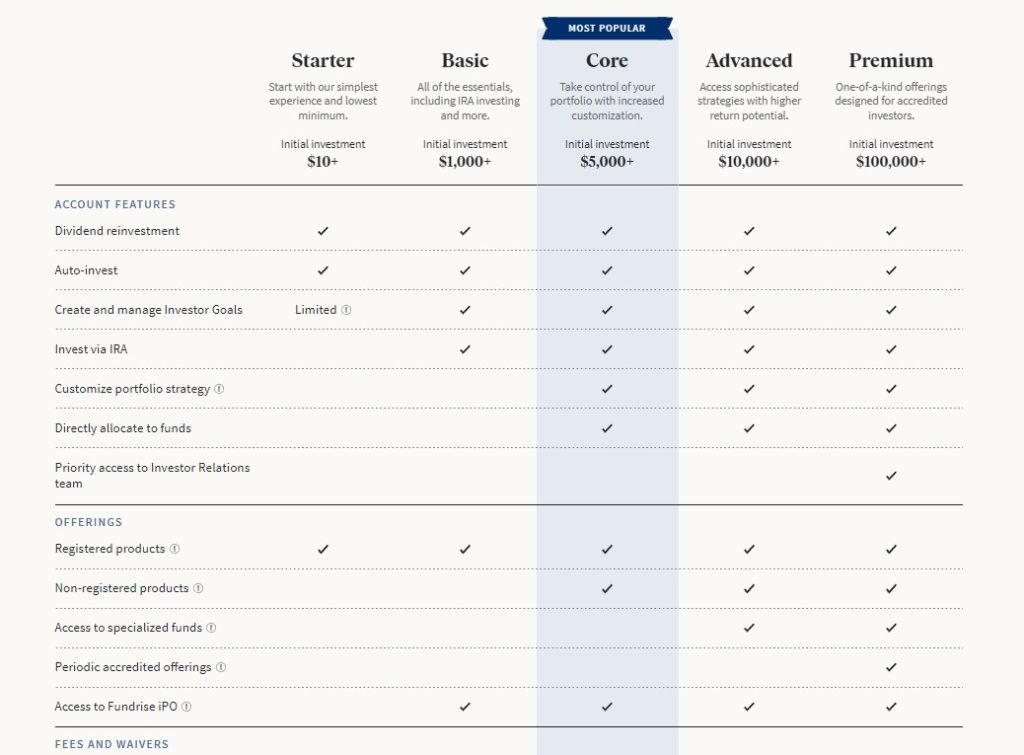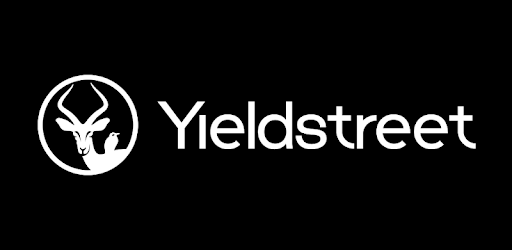Yieldstreet vs. Fundrise: Which Investment Platform Delivers Higher Yields and Greater Investor Returns?

At a Glance:
KEY FEATURES | ||
QUICK SUMMARY | An alternative investment platform for accredited and non-accredited investors that enables them to invest in alts such as real estate, art, and legal finance | Real estate investment platform that offers a wide variety of REITs and Funds with varying strategies and property types |
MINIMUM INVESTMENT | $10,000 | $10 |
FEES | Varies | 1-1.85%/yr |
INVESTMENT OPTIONS |
|
|
Who should use these platforms?
Yieldstreet is good for…
- Accredited Investors: YieldStreet’s offerings are generally limited to accredited investors. This means individuals who have earned income exceeding $200,000 (or $300,000 for joint income) for the last two years with the expectation of the same for the current year or have a net worth over $1 million, either alone or together with a spouse (excluding the value of the person’s primary residence).
- Investors Seeking Diversification: YieldStreet allows investors to diversify their portfolios beyond traditional investment products such as stocks, bonds, or mutual funds. If you’re an investor looking to broaden your portfolio with alternative assets, YieldStreet can offer this opportunity.
- Investors Seeking Passive Income: The investments on YieldStreet generally provide passive income through interest or rental payments, making it a good platform for those interested in generating steady cash flow.
- Investors with Long-term Investment Horizons: Most YieldStreet offerings have a term of 1-5 years and are not easily liquidated before the end of the term. Therefore, this platform is more suitable for investors who can afford to have their capital locked up for an extended period.
Fundrise is Good for…
- Non-Accredited and Accredited Investors: Unlike many other real estate investing platforms, Fundrise opens up opportunities to non-accredited investors, allowing more people to invest in real estate. It also offers advanced plans for accredited investors.
- Investors Seeking Diversification: Fundrise can be a great tool for portfolio diversification. It allows investors to spread their funds across multiple real estate projects rather than tying up large amounts of capital in a single property.
- Investors Interested in Passive Income: Fundrise offers eREITs (electronic Real Estate Investment Trusts) and eFunds, which typically distribute dividends, offering investors the opportunity to earn passive income.
- Long-term Investors: Fundrise’s investments are most suitable for those with a long-term investment horizon, as real estate is traditionally a long-term investment, and there may be penalties for early withdrawal.
- Investors who Prefer Hands-off Approach: For those who want to invest in real estate but don’t want the hassle of managing properties, Fundrise can be a good fit. The platform handles all the details of property acquisition, management, and disposition.
PROs and CONs
Yieldstreet
PROS
- Less than 10% of investment opportunities have made it onto the platform
- Wide range of alternative investment options
- Low stock market correlation
CONS
- Most individual investments are open only to accredited investors only (1except the prism fund)
- Limited liquidity options
Fundrise
PROS
- $10 minimum investment
- Investor goals and tools
- Wide range of real estate investment options
CONS
- Limited liquidity
- No investment options outside of real estate
What is Yieldstreet?
Yieldstreet is a crowdfunding platform that specializes in collateralized alternative investments. Alternative investments are unique because they typically have a low correlation to stock market movement.

Yieldstreet primarily caters to accredited investors who want to invest in alternative asset classes such as Art, Commercial, Consumer, Litigation Financing, Real Estate, and Corporate. All loans on Yieldstreet’s platform are asset-based, meaning they are secured by collateral, providing a way to recoup your investment in the case of a default.
Founded in 2014 by Milind Mehere and Michael Weisz, a strong duo who collectively have extensive experience in entrepreneurship and alternative investing.
Since its inception, Yieldstreet has funded over $4 billion in investments and boasts over 400,000 registered users.
The company is headquartered in New York City.
Read our full Yieldstreet Review
What is Fundrise?
Established in 2010, Fundrise is one of the oldest real estate crowdfunding platforms. Fundrise offers people an alternative option to investing in commercial real estate through its eREITs and eFunds without the stress and costs of traditional real estate investing.

In its latest foray, Fundrise has recently started to branch out of real estate through the launching of its Innovation Fund. Launched in mid-2022, the Innovation Fund invests in late-stage private technology companies and some public equities.
Fundrise boasts various investment options and strategies, goal-planning features, and a user-friendly investment dashboard.
More than 2 million people use Fundrise today and have invested over $7 billion in properties throughout the U.S. Fundrise has had 21 consecutive quarters of returns, averaging 22.99% in 2021.
Fundrise is based in Washington, DC, and was founded by Ben Miller, who has over 20 years of experience in the real estate industry.
Read our full Fundrise Review.
How does investing with Yieldstreet work?
Below, we’ll go through how Yieldstreet works, from opening an account to selecting an investment.
1. Open Your Account
Start by creating an account on the YieldStreet website. During the registration process, you’ll need to provide personal details and financial information to determine if you meet the criteria to become an accredited investor.
Once your Yieldstreet account is opened, you can view all open and some recently closed investments. After investments pass a thorough due diligence process, they are listed on the Yieldstreet platform for investing.
2. Accredited Investor Verification
To invest with YieldStreet, you must be an accredited investor. This generally means having an income exceeding $200,000 (or $300,000 combined income if married) for the past two years and expecting the same in the current year, or having a net worth over $1 million, excluding the value of your primary residence. YieldStreet will verify this information during the signup process.
Note: Individual investments are only open to accredited investors, but non-accredited investors can always invest in the Yieldstreet Prism Fund, which has a minimum investment of $10,000 and is invested across 5+ alternative asset classes. It provides quarterly distributions and liquidity options.
3. Explore Investment Options
Once your Yieldstreet account is opened, you can view all open and some recently closed investments. After investment passes a thorough due diligence process, they are listed on the Yieldstreet platform for investing.
YieldStreet provides a wide array of options, including real estate, marine finance, legal finance, and more. For each offering, you can review details like the investment premise, expected returns, and fees, to name a few.
You can also view metrics such as strategy, minimum investment, asset class, and if the investment is IRA eligible. Individual investments have a minimum investment of $10,000.

How Does Investing with Fundrise Work?
With Fundrise, you are investing in either Fundrise eREITs or eFunds with a minimum investment of just $10.
eREITs and eFunds comprise a basket of non-traded real estate properties, from multifamily apartments to industrial complexes. The eREITs and eFunds aim to seek a combination of dividend distribution and capital appreciation, depending on the strategy.
When you open an account with Fundrise, they offer a wide range of account levels; Basic accounts require a minimum investment of $10, and its Advanced Portfolio requires a minimum investment of $10,000. The premium level is reserved for accredited investors only, with a minimum investment of $100,000.
However, Fundrise’s most popular account is its ‘Core’ portfolio, which has the most investment options and features. A Core account requires a minimum investment of $5,000.
You can create a customized investment strategy at the Core account level and above. Investors can customize their portfolio by diversifying across a wider variety of funds with specific objectives, such as income, growth, and balanced.

Head-to-Head Comparison
In this Yieldstreet vs. Fundrise review, we will look closely at a few categories, including investment options, returns, fees, user experience, and much more.
Investment Options
Winner: Fundrise
Yieldstreet offers a broader range of investment options compared to Fundrise. However, you must be an accredited investor to access most of Yieldstreet’s investment offerings.
Not only does Yieldstreet offer real estate investing like Fundrise, but you can also get instant diversification by investing in their Prism Fund, which invests across 8 alternative asset classes, including real estate. The Yieldstreet Prism fund is open to non-accredited investors with a minimum investment of $10,000.
However, Fundrise is a real estate investment platform, and Yieldstreet is an alternative investing platform. Alternative investing can span many products, including art, private credit, litigation financing, and real estate.
While Fundrise does not offer many investment options outside of real estate except for its Innovation Fund, they have a wide variety of real estate eREITs and eFunds to choose from.
At the same time, Yieldstreet also offers a wide range of investment options in the alternative investment space.
Therefore, Fundrise and Yieldstreet have a respectable number of options for their respective specialty.
Yieldstreet Investment Options
Yieldstreet offers 3 types of investments to its users:
- Individual investments (available to accredited investors only) and minimum investment starts at $10,000,
- Prism Fund (Open to all investors) with a minimum investment of $10,000
- Short Term Notes (accredited investors only) with a minimum investment of $10,000.
Yieldstreet boasts a truly diverse range of alternative investments across multiple asset classes throughout the capital stack. Some of their strategies include income, growth, and balanced.
Some of Yieldstreet’s most popular investment options include:
- Prism Fund (invested across most asset classes offered by Yieldstreet)
- Real Estate (Income and Growth strategies)
- Private Credit
- Litigation Financing (Cash advances on future litigation claims)
Fundrise Investment Options
Fundrise investment options primarily focus on real estate investing across the capital stack, except for its newly launched Innovation Fund. Fundrise has 11 active eREITs and 2 eFunds. Like Yieldstreet, Fundrise strategies range from income generation to growth, with varying degrees of risk.
Returns
Winner: Yieldstreet
Yieldstreet returned 9.66% IRR (Internal Rate of Return), net of fees since 2015. Meanwhile, Fundrise returned 5.29% net of fees across all clients since 2017.
So Yieldstreet has better returns than Fundrise. However, Fundrise does not advertise its returns before 2017, so we are comparing returns between Yieldstreet and Fundrise during different periods, so take that with a grain of salt.
Yieldstreet returns: 9.66% IRR since 2015
Fundrise: 5.29% since 2017

Furthermore, while total returns are important, the returns do not take into account the level of risk involved in the investment and liquidity events.
The riskier an investment is, the greater the returns are likely(think equity investments). And conversely, the lower investment is in the capital stack (debt investment), the lower the risk and the corresponding returns will be. Many Fundrise and Yieldstreet investments invest across the entire capital stack.
As a discerning investor, it’s critical to understand that risk and return are generally correlated before investing.
In addition, Fundrise focuses on real estate investing, while Yieldstreet focuses on more esoteric asset classes, which tend to be more illiquid and should have a higher return.

Fees
Winner: Tie
Yieldstreet charges a management fee between 1 – 4%, depending on the investment. All targeted returns listed by Yieldstreet are quoted net of listing and management fees but not the flat rate annual expenses. The flat rate annual expense fee is charged on each investment and is deducted from your first interest distribution; this fee varies per investment and is applicable for each investment. There are no fees to sign-up for the Yieldstreet platform.
I wish Yieldstreet was a little bit clearer that the returns are net of management fees but not the flat rate annual expenses, I find this a little misleading and could easily be misunderstood. While it’s listed in the offering documents, I’m sure plenty of individuals overlook the flat rate expenses.
Meanwhile, Fundrise charges a 1% management fee per year, comprising a 0.85% management fee and a 0.15% advisory fee.
The management fee is used for investment allocation and advisory oversight of their real estate projects. The advisory fee is used to reimburse Fundrise for expenses related to building its platform, e.g., customized client performance reporting and customer support and investor relations.
It’s also worth noting that depending on the investment, additional fees are often buried in the offering circular that Fundrise does not advertise. All returns quoted by Fundrise are net of fees.
- Yieldstreet fees: 1-4%, depending on the investment + flat rate annual expense (which varies per investment)
- Fundrise fees: 1% of AUM (0.85% management fee + 0.15% advisory fee)
That said, there’s no clear winner when it comes to fees, so it’s a tie between Fundrise and Yieldstreet in the fees category.
User Experience
Winner: Tie
Both Yieldstreet and Fundrise have a well-designed website and investment platform, making it easy to sign-up, browse investments, and manage your portfolio.
In addition, Yieldstreet and Fundrise offer a mobile app for download in the Apple App Store and Google Play.
Yieldstreet’s incredibly well-designed interface shows you a summary of your Yieldstreet investments and their performance. You can also view your total amount invested on Yieldstreet and any accrued interest that has not been paid.


Other Features and Benefits
Outside of investing, Yieldstreet offers an FDIC-insured checking account called Yieldstreet Wallet. The Yieldstreet Wallet earns 3.25% annual interest on funds held, and your wallet is automatically created when you set up your investor account. However, 3.25% is lower than what you can earn at other “high yield” bank accounts.
On a more positive note, funds are FDIC-insured for up to $1 million. Yieldstreet Wallet also gives you the ability to move funds instantaneously between different assets on the platform, by avoiding delays caused by transferring funds from external accounts.
Meanwhile, if you invest $1,000 or more with Fundrise, you can buy an ownership stake in Fundrise, the company itself, the Fundrise iPO. Furthermore, if you refer others who sign-up and invest with Fundrise, you can earn bonus shares between $25 and 100 per referral.
- Yieldstreet other benefits: FDIC-Insured High Yield Checking Account
- Fundrise other benefits: Ability to invest in the Fundrise iPO and $25 – $100 referral bonuses.
Bottom Line
The truth is that Yieldstreet is more of an alternative investing platform, and Fundrise is primarily a real estate crowdfunding platform. While both platforms have delved slightly out of their specialties over the past few years, it’s best to stick with the basics.
If you are more interested in strictly real estate investing, Fundrise is a better option. However, if you want to invest in alternative assets with non-correlated returns outside of real estate, Yieldstreet is a better option.
That said, Yieldstreet only caters to accredited investors except for its Prism Fund offering, making it an unavailable option for many investors. Meanwhile, Fundrise focuses on non-accredited investors, and therefore you can sign-up with just $10.
Either way, both Yieldstreet and Fundrise are legitimate investing platforms that have been around for many years. Both platforms offer an excellent alternative to investing outside publicly traded stocks, ETFs, and bonds.
Review Methodology
When I decided to compare Yieldstreet and Fundrise, I knew there were a few critical aspects to consider.
Tools and Features
We dig deep into the suite of tools that each platform offers. Whether it’s automated investment features, tax-optimization, or specialized charting tools, we evaluate how these features contribute to smarter investing decisions. We ask questions like:
- What is the investment offering, and how does it compare to its peers?
- How effective are the risk assessment tools?
- Are there any value-added services like educational content?
Price and Value
Price matters, especially when it comes to investing, where every penny counts. We analyze:
- Subscription fees
- Hidden Charges
- Price compared to the overall value received
We’ll let you know if the platform gives you the most bang for your buck.
Ease of Use
User experience can make or break an investment platform. We assess:
- Interface Design – Is it intuitive and easy to use?
- Mobile app availability and functionality
- Customer Support – where applicable.
Nobody wants to navigate a clunky interface when dealing with their hard-earned money.
Returns
We compare total returns and try to make an unbiased analysis of any investment returns taking into account any nuances of the asset class.
How We Do It
- Hands-On Testing: We sign up for accounts and put the platform to the test. This is how we give our nuanced opinion.
- Customer Reviews: What are other users saying? We look at reviews and customer feedback to gauge public opinion. I may overlook a feature or functionality that others may notice.
- Comparative Analysis: Finally, we compare each platform against competitors in terms of features, pricing, and user experience.
We take a comprehensive approach so that you don’t have to.
By sticking to this methodology, I hope to guide you toward investment tools and products that align with your financial objectives. Happy investing!






